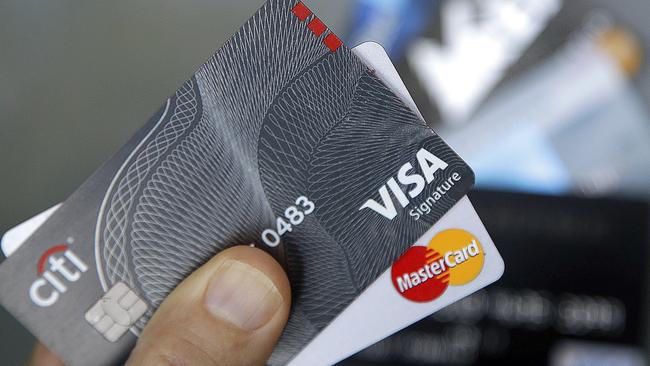Credit card foreign transaction fees ‘a form of gouging’
Banks are gouging consumers of $850m a year from foreign transaction fees, according to an analysis of data.

Banks and other financial institutions are gouging consumers to the tune of $850 million a year from foreign transaction fees, according to analysis of data obtained by The Weekend Australian.
The “foreign currency” or “overseas” transaction fee (typically 3 per cent) that banks tack on to their customers’ Visa or Mastercard purchases made in foreign currency (via the internet or travelling abroad) have earned the big four banks alone $1.24 billion over the past two years.
Payment system experts say the fees are charged by financial institutions “simply because they can be”, raising questions about the level of competition in the banking sector.
“It’s absolutely a form of gouging and unless there’s attention drawn to it, consumers will keep copping it,” said Grant Halverson, chief executive of consulting firm McLean Roche.
Australians made about $28bn in foreign currency transactions on their Visa and Mastercard credit and debit cards last year, up 9.5 per cent from a year earlier, according to confidential data provided by top industry sources.
Justin Rampono, a former banker with 17 years’ experience in foreign exchange, said the cost to banks of making the card transactions were dramatically lower than 3 per cent fee suggested. “Most people have no idea that this fee is being taken and the actual foreign exchange conversion costs the banks nothing,” he said.
Visa and Mastercard, the world’s biggest credit and debit card schemes, charge banks that issue their cards a special “scheme fee” of about 1 per cent of the value of their customers’ foreign card transactions.
“The banks more than make up for that by the considerable amount of money they earn from the special interchange fees they get from foreign merchants and banks,” said Andy Mitchell, chief growth officer at ZipMoney.
According to the Reserve Bank’s most recent payments review, banks are paid an “interchange fee” of between 1.5 and 2 per cent of the value of their customers’ foreign purchases, suggesting a mark-up of at least 50 per cent on foreign transactions, before factoring in the 3 per cent fee they charge consumers.
“They charge these fees simply because they can,” said Mr Rampono, now chief executive of Currency Shop, which advises on currency transactions. Another payments insider, who preferred not to be named, likened the 3 per cent fees to “gravy”.
In November, ING joined a handful of banks in abolishing the fee on its debit and credit cards, pointing out that its customers were “travelling and shopping internationally” more.
“In the six weeks since making our announcement, we’ve seen a significant shift (to us),” said ING’s head of retail banking Melanie Evans.
The big four banks, which each charge their customers 3 per cent for such transactions, had 76 per cent of the credit card market last year.
HSBC, which also charges 3 per cent, said it was “working towards an additional card product that offers lower FX transactions” in Australia.
“Our card fees are in line with industry and reflect the range of costs we incur in providing a product to customers, such as payments to card schemes, credit losses and general servicing,” a spokeswoman said.
Reserve Bank fee data shows credit card foreign exchange fees have almost tripled from 1 per cent in 2002 to an average of 2.8 per cent last year, a period during which the value of foreign currency shopping has grown strongly.
“If you go back to pre-2000, there was no FX surcharge; the only thing credit and charge cards got was the mark-up on FX rate,” Mr Halverson said, noting annual membership fees on credit cards had risen from $24 in 2000 to $48.
The Productivity Commission’s inquiry into the level of competition in the financial system is due to report in July.




To join the conversation, please log in. Don't have an account? Register
Join the conversation, you are commenting as Logout